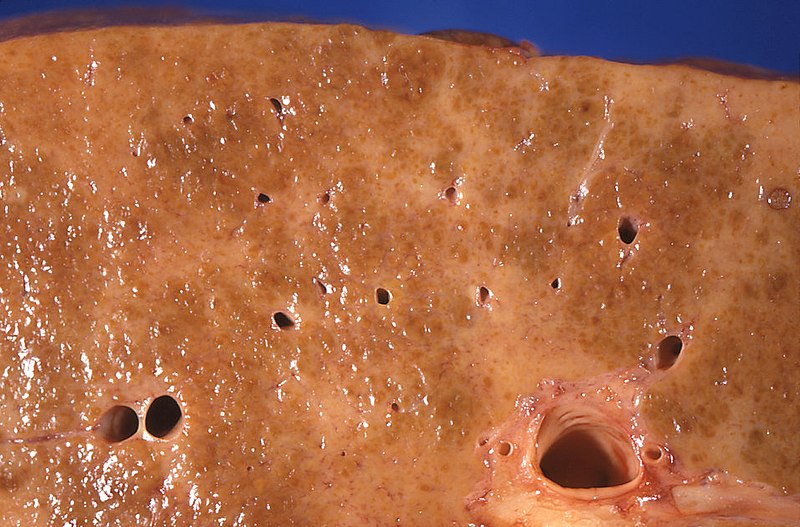Playlist
Show Playlist
Hide Playlist
Spontaneous Bacterial Peritonitis (SBP) with Case
-
Slides Gastroenterology 13 Liver Pt3 End Stage Liver Disease.pdf
-
Reference List Gastroenterology.pdf
-
Download Lecture Overview
00:02 We will now move to our next case. 00:04 A 52-year-old woman is hospitalized for 3 days of abdominal pain and fever. 00:09 She has a history of decompensated alcohol-associated cirrhosis with ascites managed with diuretics. 00:16 Her medications are furosemide, spironolactone and lactulose. 00:20 Vitals are notable for a temperature of 38 C, blood pressure 115/60 mmHg, and heart rate 110 bpm. 00:27 Her abdomen is distended and moderately tender to palpation with a positive fluid wave. 00:33 Lab studies show a bilirubin of 4.5 (mg/dL), serum creatinine of 1.3 (mg/dL) and white cell count of 12,000 (x10^9). 00:41 What is the next best step to confirm the diagnosis? So let's review this case. 00:47 She has new onset abdominal pain and fever. 00:50 So in a patient with decompensated cirrhosis and ascites, we should be very concerned. 00:56 In addition, she's febrile, tachycardic and has localizing signs of some perhaps an infection in the abdominal area. 01:06 Her labs show high serum bilirubin and an abnormal creatinine which can alter the treatment in this condition. 01:14 So let's talk next about spontaneous bacterial peritonitis or SBP. 01:20 This is simply an infection of the ascitic fluid. 01:25 It has a high mortality risk of about 10 to 20%. 01:30 Patients may come in with abdominal pain, they may have fever, new onset hepatic encephalopathy or they may have acute kidney injury. 01:41 The diagnosis must be done with paracentesis. 01:44 That's by inserting a needle into the peritoneal space and withdrawing some fluid that we can then send for analysis. 01:51 The diagnostic criteria for SBP are you must have: a polymorphonuclear count of greater that 250 u/L, or you may have below this threshold but have a positive bacterial culture in a patient who has symptoms. 02:07 The treatment is with a 3rd generation cephalosporin and you may give IV albumin for selected patients. 02:17 So let's take a quick break to talk about a high-yield learning point. 02:21 Any patient who has ever had a history of SBP should receive lifelong SBP prophylaxis with any of the medications listed here: norfloxacin, ciprofloxacin or trimethoprim-sulfamethoxazole. 02:38 Now let's take a step back and talk about ascites. 02:41 So the initial work-up of ascites must be done with an ultrasound to assess the ascites burden and a diagnostic paracentesis the very first time ascites is noted in our patient. 02:54 This is important because we want to know the etiology of their ascites. 02:58 So we send that fluid off for albumin, a measure of their total protein and a cell count. 03:05 This is all to confirm that their ascites is truly due to cirrhosis and not another cause. 03:11 We do this by calculating the serum ascites albumin gradient which we will discuss next. 03:19 In terms of basic ascites management, we want to prevent the build up of ascites by restricting the sodium in the patient's diet, giving diuretics like furosemide and spironolactone and in some cases, we may do a procedure called a TIPS. 03:35 This is a transjugular intrahepatic portosynthetic shunt. 03:39 Basically, it diverts blood flow from the portal vein into the systemic system. 03:46 We usually only do this procedure if patients have ascites refractory to the above treatments because it has a high risk of complications. 03:56 So earlier we mentioned the serum ascites albumin gradient or the SAAG. 04:01 This is a simple calculation by measuring the serum albumin and subtracting the ascites albumin. 04:07 By doing this, we can differentiate between causes with a SAAG of greater than or equal to 1.1 which indicates that the ascites is developed from high portal pressure, the most common cause of which is portal hypertension. 04:21 When the SAAG is less than 1.1, this usually indicates ascites from causes that are not associated with increased portal pressure. 04:31 We can also further differentiate the origin of ascites based on the ascites total protein. 04:37 That's why that test is important to get when you first encounter a patient with new ascites. 04:42 So, we won't go into this in too much detail since this is beyond the scope of this lecture, but know that the total protein in the ascites can help you differentiate between cirrhosis and the other causes. 04:54 So now let's return to our case. 04:56 Our 52-year-old woman with new onset abdominal pain and fever with decompensated cirrhosis. 05:03 She's febrile, tachycardic, has potential signs of an infection. 05:07 And her labs with a high bilirubin and creatinine may alter the treatment. 05:12 So, what is the best next step to confirm the diagnosis? We should at this point suspect SBP. 05:19 So we now know that the best test to confirm the diagnosis is diagnostic paracentesis.
About the Lecture
The lecture Spontaneous Bacterial Peritonitis (SBP) with Case by Kelley Chuang, MD is from the course Disorders of the Hepatobiliary Tract.
Included Quiz Questions
Which of the following medications is used for lifelong SBP prophylaxis?
- Ciprofloxacin
- Vancomycin
- Erythromycin
- Tetracycline
- Doxycycline
Which of the following medications is used for the treatment of SBP?
- IV third-generation cephalosporins
- Macrolides
- Tetracyclines
- Aminoglycosides
- Glycopeptides
Which of the following is the best confirmatory test for SBP?
- Diagnostic paracentesis
- Ultrasonography
- Thoracentesis
- Abdominal CT
- Urinalysis
Customer reviews
5,0 of 5 stars
| 5 Stars |
|
2 |
| 4 Stars |
|
0 |
| 3 Stars |
|
0 |
| 2 Stars |
|
0 |
| 1 Star |
|
0 |
Easy to understand, straight-to-the-point lecture! I wished I had seen this when I was doing my IM rotation.
A concise yet complete presentation of SBP. Using a case to present a disease helps to consolidate the concepts in mind. Thank you.




